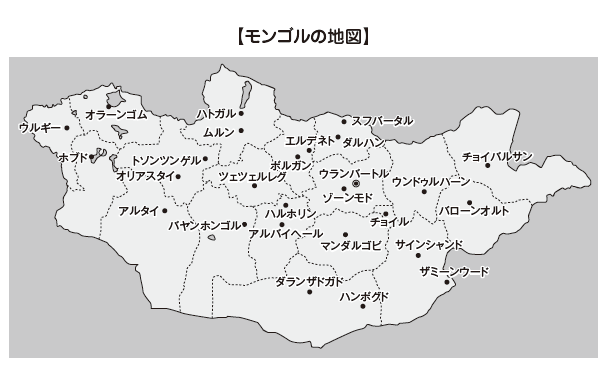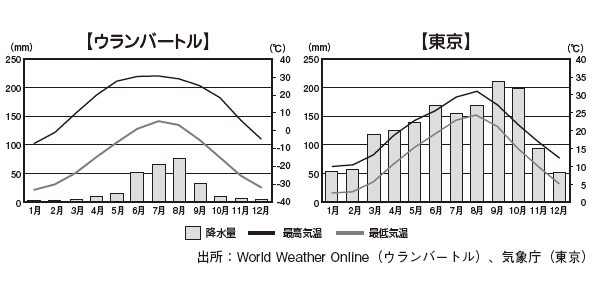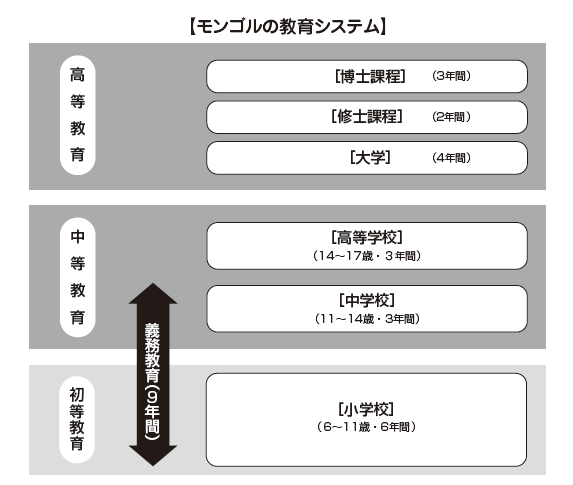Mongolia
1 Chapter Basic knowledge
-
-
1 Chapter Basic knowledge
2 Chapter Investment Environment
2.4 Investment regulation and incentives
3 Chapter Establishment
3.1 Characteristics of business base
3.2 Establishment of business base
3.3 Liquidation and withdrawal
4 Chapter M&A
4.2 Laws and regulations concerning M & A
5 Chapter Corporate Law
5.1 Organization of the company
6 Chapter Accounting
7 Chapter Tax
7.2 Individual Issues of Domestic Tax Law
7.5 Tax survey and tax penalty
8 Chapter Labor
8.4 Foreign Employees in Mongolia
9 Chapter Q&A
-
-
-
Basic knowledge
■ Formal Country ➡ MongoliaMongolian Language Name: МонголУлс (Mongol Ols) English Name: Mongolia
National flag
The flag of Mongolia is divided into three by red and blue, red means "progress and prosperity", "victory and delight", and blue means "eternal blue sky", "loyalty and dedication".
In the red area on the left, Seo Yombo (marks peculiar to Mongolia) is drawn and each figure represents "prosperity, sacredness, sovereignty, nobility, freedom and unity" and "fire, earth, water, sun, moon. There are various theories such as Yin.
■ Area · Country ➡ 1,565,000 ㎢ (about 4 times as large as in Japan)Mongolia is an inland country sandwiched between two major powers of the Eurasian continent, Russia and China. The north side is in Russia's Siberian Federal District, and the south side is in contact with Xinjiang Uygur Autonomous Region of China and Inner Mongolia Autonomous Region. The maximum distance in the east and west is 2,392 km, the maximum distance in the north and south is 1,259 km.

■ Capital ➡ Ulan Bator Turkish Mongolian Name: Улаан баатар (Ulan Bator) English Name: Ulaanbaatar
Ulaanbaatar is a capital city of this country, meaning "red hero" located at a high altitude of 1,350 m above sea level in central Mongolia. It is the political and economic center, the hub of transportation, the most popular city in Mongolia, where the concentration is concentrated. The population of Ulaanbaatar is 1.28 million (as of 2012), about 46% of the total population of Mongolia. Compared with the population of Ulaanbaatar, the population of Ulaanbaatar continues to increase compared to 760,000 in 2000 (about 32% of the total population), the population density is much higher than other areas, 272 people / per capita, housing shortage, and it is enough to have occurred.
Climate
The land of Mongolia has geographical and topographical features that it is inland, more than 2,000 km from the sea, high latitude, and high altitude above 1,500 m above average sea level. The climate as a whole has an inland climate, the temperature difference between summer winters and day and night is large, the humidity is low, and the coldness in winter is severe.
From the central part to the eastern part, gently rolling hills and vast grasslands spread, fertile forest grasslands in the north, desert plains called Gobi spreading in the High Mountain and lake area of 3000 m class in the west and Gobi in the south.
Ulaanbaatar is said to be one of the coldest capital cities in the world, with an average annual temperature of zero. In winter, due to the influence of the seasonal wind from Siberia, the average temperature drops to -20 ℃. In the summer, it is easy to spend the morning and evening, but during the day the temperature will rise above 30 ℃.

■ Time difference ➡ Ulan Bator: -1 hour (UTC + 8)Until now, the time difference with Japan was 1 hour in Ulaanbaatar, but daylight saving time has been resumed from 28th March 2015. However, due to adopting time zone of 1 hour late UTC + 8 in the western Hobud County, it will be an hour difference.This summer time will end on September 26, 2015, and next will start on March 26, 2016. Therefore, when the winter time comes, Japan will have an hour difference between Japan and 1 hour.
■ Population ➡ 3.1 million people May 15, 2015 Mongolia National Statistics Bureau data)Although Mongolia is the country with the lowest population density among the countries that are members of the United Nations, the population has increased by about 400,000 in the past 10 years and it was 2 million by January 2015, but 2015 On January 24th the total population exceeded 3 million people. The average life expectancy and the total birth rate are close to the world average, 66 years old and 76 years old. The death rate of newborns and infants is somewhat lower, and steady population growth is anticipated although they are not explosive in the future..png) ■ Language ➡ Mongolian (official language)The official language is Mongolian, 95% of the people use it. The notation is Cyrillic (Russian alphabet). Vongitudinal Mongolian letters that have been traditionally used have been changed to Cyrillic notation under the Soviet regime under the socialist regime of the 1940s. With the collapse of the former Soviet Union and the rise of ethnic consciousness, the movement of resurrection of the Mongolian character has increased, but the Mongolian character has already been discontinued because the image of literature has already established among the people.In Bayannulgy County of the West, Kazakh language is used as a common language together with Mongolian language in school education.Almost everyone understood Russian as Russian influence was large in socialist era and Russian was included in compulsory education. Since the democratization of the 1990s, foreign language education such as English and Japanese has become popular.
■ Language ➡ Mongolian (official language)The official language is Mongolian, 95% of the people use it. The notation is Cyrillic (Russian alphabet). Vongitudinal Mongolian letters that have been traditionally used have been changed to Cyrillic notation under the Soviet regime under the socialist regime of the 1940s. With the collapse of the former Soviet Union and the rise of ethnic consciousness, the movement of resurrection of the Mongolian character has increased, but the Mongolian character has already been discontinued because the image of literature has already established among the people.In Bayannulgy County of the West, Kazakh language is used as a common language together with Mongolian language in school education.Almost everyone understood Russian as Russian influence was large in socialist era and Russian was included in compulsory education. Since the democratization of the 1990s, foreign language education such as English and Japanese has become popular.
■ Currency ➡ TugrugThe currency is Tugrug (Төгрөг, Tugrug, abbreviated name MNT). According to the Central Bank Act, the currency of Mongolia consists of paper money and coins. The types of banknotes and coins issued by the central bank are 16 kinds in comparison with Japan. There are eleven banknotes of 1, 5, 10, 20, 50, 100, 500, 1,000, 5,000, 10,000, 20,000, and 5 kinds of coins are 20, 50, 100, 200, and 500. However, since the method of using coins is limited, only bank notes are actually used.■ Religion ➡ Tibetan Buddhism
According to the data of the National Bureau of Statistics in 2011, 64.4% of the population aged 15 and over believed religion, 86.2% of which are Buddhism, 4.9% Islam, 3.5% Christianity, 4.7% shamanism, other religions occupy 0.6%.
Most Buddhists occupying the majority in Mongolia are Tibetan Buddhism. In addition, Shamanism, which had been believed before from the arrival of Tibetan Buddhism, is also rooted. In addition, although it is a small number, Islam believes such as the Kazakh people who live in the western region, and recently new Christianity has become popular.
In Mongolia, the socialist era that was under the powerful influence of the Soviet Union, Tibetan Buddhism has received political repression. In particular, hundreds of temples and monasteries were destroyed during the 1930s and 1940s, and it is said that tens of thousands of monks were killed. Over the years since then, Mongolian Tibetan Buddhism has remained tightly under strict control.
However, after the collapse of the Soviet Union in the 1990s and democratization of Mongolia, rebuilding of temples and monasteries is actively undertaken with the freedom of religion.
■ Political system[Political system]Republic (Combined use of presidential system and parliamentary cabinet system)
Head of statePresident: Zacher Elbegdorgi (Democratic Party of Japan)
[Council]National Conference (Unicameral, 76 people capacity, 4 years term)
[Government]Prime Minister: Timedo Saahambireg (Democratic Party) Foreign Minister: Rundg Prevslen (Democratic Party)The president was elected by the people's direct vote, and the term of office is four years, and it is up to two consecutive years eight consecutive years. The president has the veto power of the bill passed by Congress and the right to appoint a prime minister but it is the first time that the president is able to become the president only after the Congress has recognized the winner of the presidential election, It is characterized by what I am doing.At the National Conference, the Mongolian People's Revolutionary Party (now the Mongolian People's Party) won the victory in the first general election after democratization, but the administration change has occurred every time in the subsequent four general elections. In addition to just changing the regime, it has become a coalition government and the two parties are forming a coalition. As of 2015 there are 22 political parties including small parties. The current president is Mr. Zacher Elbegdorj and the fourth president since democratization. Mr. Elbegdorj and Mr. Thimed · Sahambireg, the current Prime Minister are both Democrats.
■ Main history
[Mongol Empire (former) ~ Domination with Qing Dynasty]
In 1206, Temuzin, which unified the tribe of the Mongolian Plateau, founded the "Mongol Empire" (later former) as Genghis Khan. Later, a great empire was built with the power of the extensive area of the Eurasian continent from the Korean Peninsula to the capital of the capital (present Beijing), the whole of China from the Korean Peninsula, Central Europe and the Northern India.
After that, after the division within the Empire, the former disappears, after the era of the ruler of the arrogance, there is an era of invasion by the Han Chinese people and the rule of the Qing Dynasty, which is the Manchu ethnic group, It was 20th century of the beginning until other ethnic rule continued.
[Xinhai Revolution and independence of Mongolia]
In 1911, the Xinhai Revolution will occur at the end of the weakened Qing Dynasty. As a result, Mongolia will be out of control over the 221 years by the Qing Dynasty. In 1917, the Russian revolution occurred, the Mongolian People's Party (later People's Revolution Party) was formed in 1920, and in 1924, the second socialist country in the world under the aid of the Soviet Union "Mongol People's Republic " was established.
Various attempts and failures in the socialist system of People's Revolution Party dictatorship were also in Mongolia. Many riots occurred due to radical socialist policy such as nomadic forced farming, grouping, mechanization, religious oppression and so on, and ten thousands of wealthy nomads and Tibetan Buddhist monks were executed as masterminds of riots.
[Continuation of Soviet Conflict and Child Road]
After World War II, China approved the People's Republic of Mongolia as a nation in 1946, and in 1962 he will fulfill the United Nations accession. After that, the parent Soso line continued in a consistent manner with the assistance and pressure from the Soviet Union, and the time when the Soviet conflict intensified remained unchanged, even being even ridiculed as "the 16th Republic of the Soviet Union”.
[Economic system reform and transition to a democratic country]
When perestroika (reform) began in the USSR, Ohorothyron and Bigorard (Perestroika) also occurred in Mongolia. The basic policy of the reform of the economic system was decided at the 19th People's Revolutionary Party Conference in 1986, and the movement of reform became full scale.
In 1990 the People's Revolutionary Party dictatorship was abandoned and became a multi-party system in the framework of the socialist regime, Otirubato was elected to the first president. And in 1992 the new Constitution came into effect, abandoning the socialist state, amended the official name as "Republic of Mongolia" as a republic state.
In economic reform, many state-owned enterprises were privatized, and state-owned assets were distributed. In diplomacy, we decided to shift policy towards parents and sisters, to normalize relations with China, and to promote multifaceted relationships with Europe, America, Japan, etc.
■ Education system
The educational system of Mongolia has been changed in 2008, and it is moving from 11 years old until the 12 year system (6-3-3 system). Elementary school entrance is 6 years old. 6 years from 1st grade to 6th grade (during transition from 5 year system to 6 year system, now 6th grade is a grading), junior high school from grade seven (7) to grade nine (9), and senior high school from grade ten (10) to grade twelve (12). Nine (9) years from the grade one (1) to the grade nine (9) are compulsory education. The university has 4 years (medical faculty etc. 6 years), the graduate school has a master's degree for 2 years and a doctoral course 3 years.
Education in Mongolia has changed greatly both after institutionalization and democratization, and it is said that it is still in the process of transformation. The ideology education and the foreign language education which was overwhelmingly Russian language changed completely. After democratization, educational opportunities in English and Japanese rapidly increase, and study abroad in Japan is also thriving.

-
-
-
References
・外務省
-



 Japan
Japan UnitedStates
UnitedStates China
China Hong Kong
Hong Kong Mongolia
Mongolia Russia
Russia Thailand
Thailand Vietnam
Vietnam Laos
Laos Cambodia
Cambodia Myanmar
Myanmar Indonesia
Indonesia Philippines
Philippines Singapore
Singapore Malaysia
Malaysia India
India Bangladesh
Bangladesh Pakistan
Pakistan Sri Lanka
Sri Lanka Mexico
Mexico Brazil
Brazil Peru
Peru Colombia
Colombia Chile
Chile Argentina
Argentina DubaiAbuDhabi
DubaiAbuDhabi Turkey
Turkey South Africa
South Africa Nigeria
Nigeria Egypt
Egypt Morocco
Morocco Kenya
Kenya